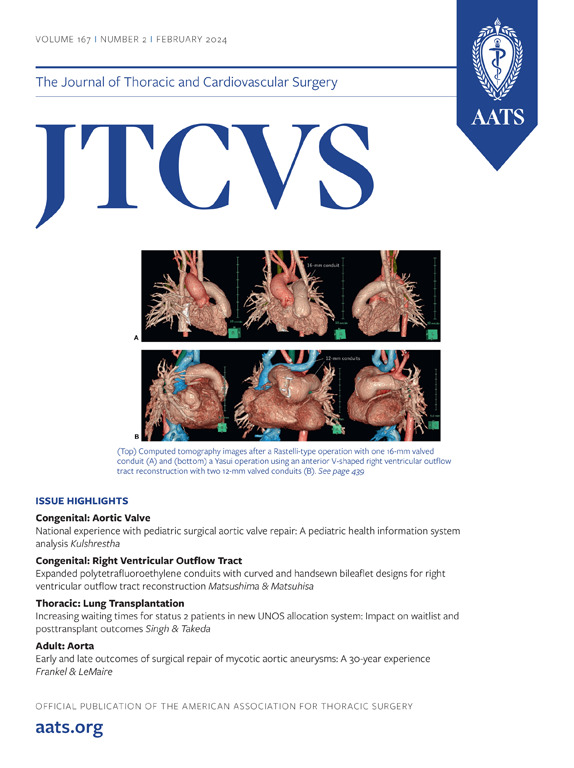胸腺恶性肿瘤和非胸腺恶性肿瘤的手术治疗:一项全国性的纵向研究。
IF 4.4
1区 医学
Q1 CARDIAC & CARDIOVASCULAR SYSTEMS
Journal of Thoracic and Cardiovascular Surgery
Pub Date : 2025-10-01
DOI:10.1016/j.jtcvs.2025.05.017
引用次数: 0
摘要
目的:先前的临床系列和登记分析已经确定胸腺恶性肿瘤(TM)和非胸腺恶性肿瘤(NTM)之间的联系,观察到的同时或随后的TM诊断。胸腺恶性肿瘤(SfTM)手术对后续NTM风险的影响存在争议。我们的目的是在全国范围内评估这种影响。方法:使用法国国家出院数据库(2014-2023),对首次诊断为TM (ICD-10代码C37)作为主要出院诊断的成人进行回顾性队列研究。排除2015年之前或确诊后6个月内的NTM患者。主要结局为NTM,以SfTM为主要暴露。我们在完整和倾向评分匹配的样本中测量了不同治疗组的NTM发病率。使用随时间变化的调整风险比(aHR)和优势比(aOR)估计相关性。结果:在3,611例TM患者中,2,616例(72.4%)接受了SfTM治疗,无论是单独治疗(n=2,114)还是采用多模式治疗(n=502)。在有和没有SfTM的患者中,NTM的发病率分别为每1000人年30.08 (95% CI, 26.21-33.96)和53.50 (95% CI, 44.26-62.73) (logp < 0.001)。在完整样本中,SfTM后NTM的aHR为0.85 (95% CI, 0.80-0.90;P < 0.001)。在匹配样本中,aOR为0.66 (95% CI, 0.52-0.83;P < 0.001)。肺癌的发病率降低幅度最大(aHR 0.79, 95% CI, 0.72-0.86;P < 0.001)。结论:SfTM与胸腺瘤患者NTM发生率降低有关。本文章由计算机程序翻译,如有差异,请以英文原文为准。
Surgery for thymic malignancy and nonthymic malignancy incidence: A national longitudinal study
Objective
Previous clinical series and registry analyses have identified a link between thymic malignancies and nonthymic malignancies observed concurrently or subsequent to a thymic malignancy diagnosis. The impact of surgery for thymic malignancies on the risk of subsequent nonthymic malignancies is controversial. We aimed to evaluate this impact in a nationwide setting.
Methods
Using the French National Discharge Database (2014-2023), we conducted a retrospective cohort study of adults diagnosed with a first thymic malignancy (International Classification of Diseases, 10th Revision code C37) recorded as the primary discharge diagnosis. Patients with nonthymic malignancies diagnosed before 2015 or within 6 months of thymic malignancy diagnosis were excluded. The primary outcome was nonthymic malignancies, with surgery for thymic malignancies as the main exposure. We measured nonthymic malignancies incidences across treatment groups in complete and propensity score–matched samples. Associations were estimated using time-dependent adjusted hazard ratios and odds ratios.
Results
Among 3611 patients with thymic malignancy, 2616 (72.4%) underwent surgery for thymic malignancies, either alone (n = 2114) or within a multimodality approach (n = 502). The incidence of nonthymic malignancies was 30.08 (95% CI, 26.21-33.96) and 53.50 (95% CI, 44.26-62.73) per 1000 person-years in patients with and without surgery for thymic malignancies, respectively (log P < .001). In the complete sample, the adjusted hazard ratio of nonthymic malignancies after surgery for thymic malignancies was 0.85 (95% CI, 0.80-0.90; P < .001). In matched samples, the adjusted odds ratio was 0.66 (95% CI, 0.52-0.83; P < .001). Lung cancer showed the largest incidence reduction (adjusted hazard ratio, 0.79, 95% CI, 0.72-0.86; P < .001).
Conclusions
Surgery for thymic malignancies was associated with a reduced incidence of nonthymic malignancies in patients with thymoma.
求助全文
通过发布文献求助,成功后即可免费获取论文全文。
去求助
来源期刊
CiteScore
11.20
自引率
10.00%
发文量
1079
审稿时长
68 days
期刊介绍:
The Journal of Thoracic and Cardiovascular Surgery presents original, peer-reviewed articles on diseases of the heart, great vessels, lungs and thorax with emphasis on surgical interventions. An official publication of The American Association for Thoracic Surgery and The Western Thoracic Surgical Association, the Journal focuses on techniques and developments in acquired cardiac surgery, congenital cardiac repair, thoracic procedures, heart and lung transplantation, mechanical circulatory support and other procedures.

 求助内容:
求助内容: 应助结果提醒方式:
应助结果提醒方式:


